Sustainable Development: Brownfield Site Guiding Principles
VerifiedAdded on 2023/06/10
|14
|3885
|131
Report
AI Summary
This report explores the importance of sustainability in the built environment, focusing on the redevelopment of brownfield sites in the UK. It identifies guiding principles for transforming brownfield sites into housing and small parks, emphasizing energy savings, sustainable building materials, water conservation, research and innovation, sustainable design, waste reduction, and indoor air quality. The report also discusses how these principles align with key UK legislation, guidance, and targets, including the National Planning Policy Framework (NPPF). Challenges such as lack of infrastructure, poor project planning, and risk management are addressed, highlighting the importance of guiding principles in achieving a sustainable built environment and promoting economic prosperity. The report concludes by suggesting methods for measuring and accrediting the achievement of these guiding principles.
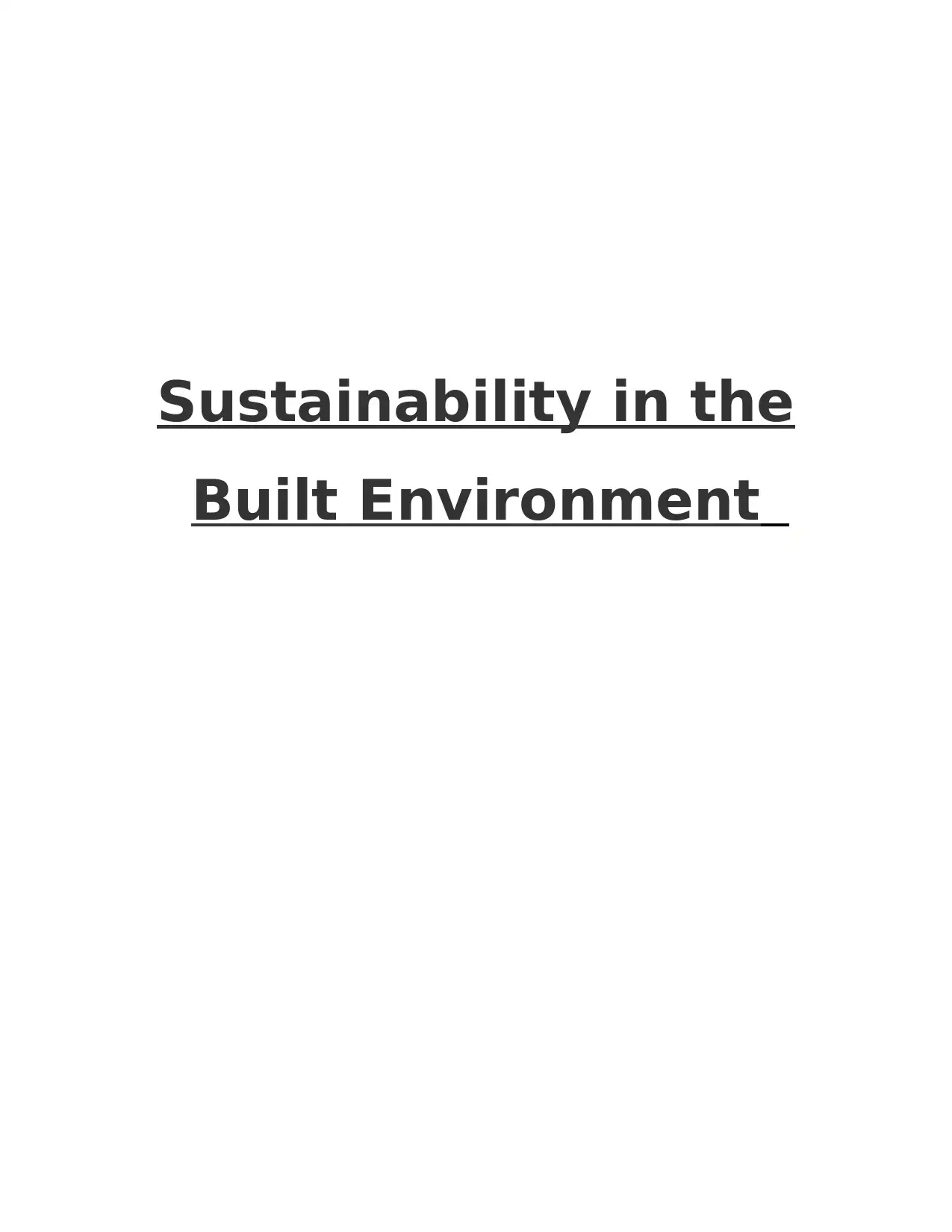
Sustainability in the
Built Environment
Built Environment
Secure Best Marks with AI Grader
Need help grading? Try our AI Grader for instant feedback on your assignments.
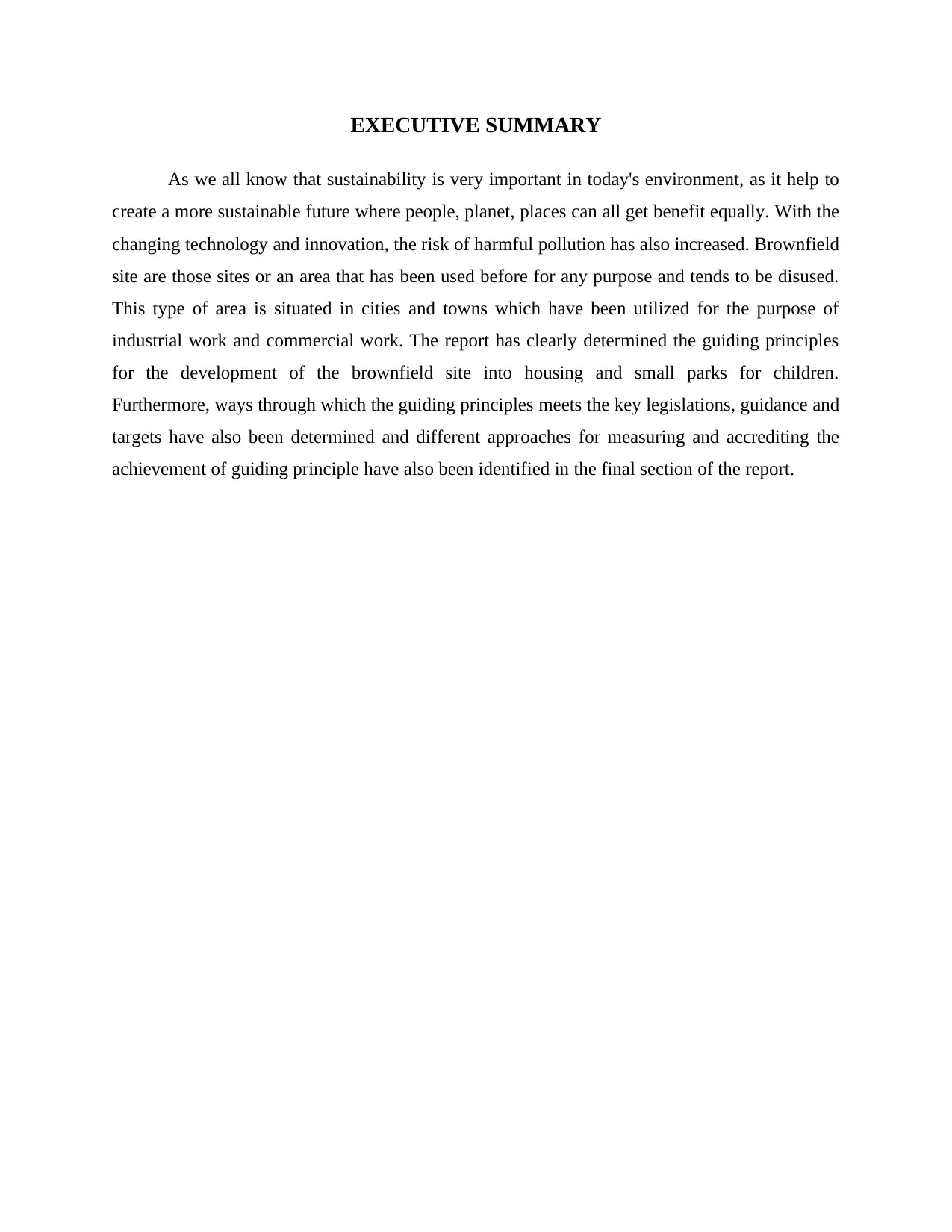
EXECUTIVE SUMMARY
As we all know that sustainability is very important in today's environment, as it help to
create a more sustainable future where people, planet, places can all get benefit equally. With the
changing technology and innovation, the risk of harmful pollution has also increased. Brownfield
site are those sites or an area that has been used before for any purpose and tends to be disused.
This type of area is situated in cities and towns which have been utilized for the purpose of
industrial work and commercial work. The report has clearly determined the guiding principles
for the development of the brownfield site into housing and small parks for children.
Furthermore, ways through which the guiding principles meets the key legislations, guidance and
targets have also been determined and different approaches for measuring and accrediting the
achievement of guiding principle have also been identified in the final section of the report.
As we all know that sustainability is very important in today's environment, as it help to
create a more sustainable future where people, planet, places can all get benefit equally. With the
changing technology and innovation, the risk of harmful pollution has also increased. Brownfield
site are those sites or an area that has been used before for any purpose and tends to be disused.
This type of area is situated in cities and towns which have been utilized for the purpose of
industrial work and commercial work. The report has clearly determined the guiding principles
for the development of the brownfield site into housing and small parks for children.
Furthermore, ways through which the guiding principles meets the key legislations, guidance and
targets have also been determined and different approaches for measuring and accrediting the
achievement of guiding principle have also been identified in the final section of the report.
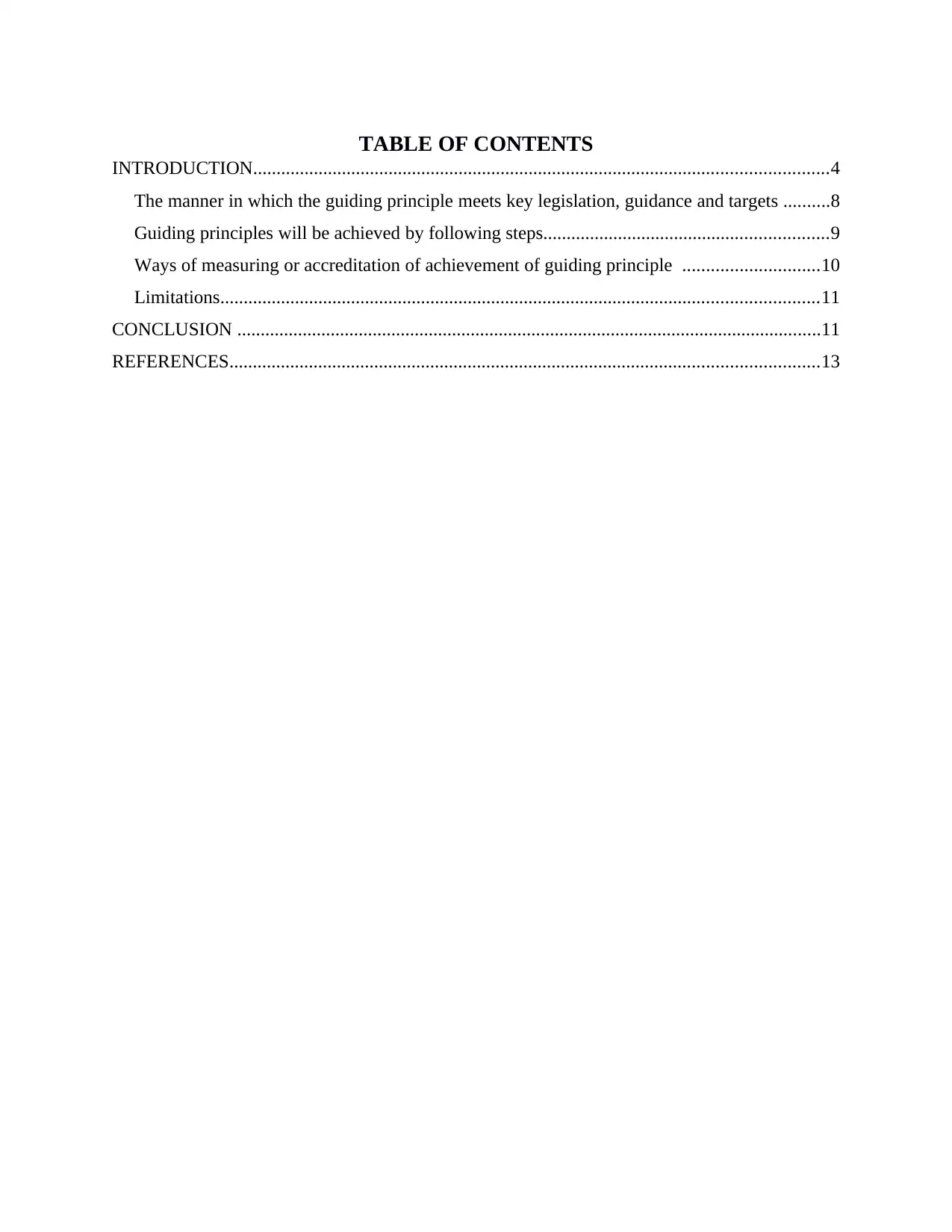
TABLE OF CONTENTS
INTRODUCTION...........................................................................................................................4
The manner in which the guiding principle meets key legislation, guidance and targets ..........8
Guiding principles will be achieved by following steps.............................................................9
Ways of measuring or accreditation of achievement of guiding principle .............................10
Limitations................................................................................................................................11
CONCLUSION .............................................................................................................................11
REFERENCES..............................................................................................................................13
INTRODUCTION...........................................................................................................................4
The manner in which the guiding principle meets key legislation, guidance and targets ..........8
Guiding principles will be achieved by following steps.............................................................9
Ways of measuring or accreditation of achievement of guiding principle .............................10
Limitations................................................................................................................................11
CONCLUSION .............................................................................................................................11
REFERENCES..............................................................................................................................13
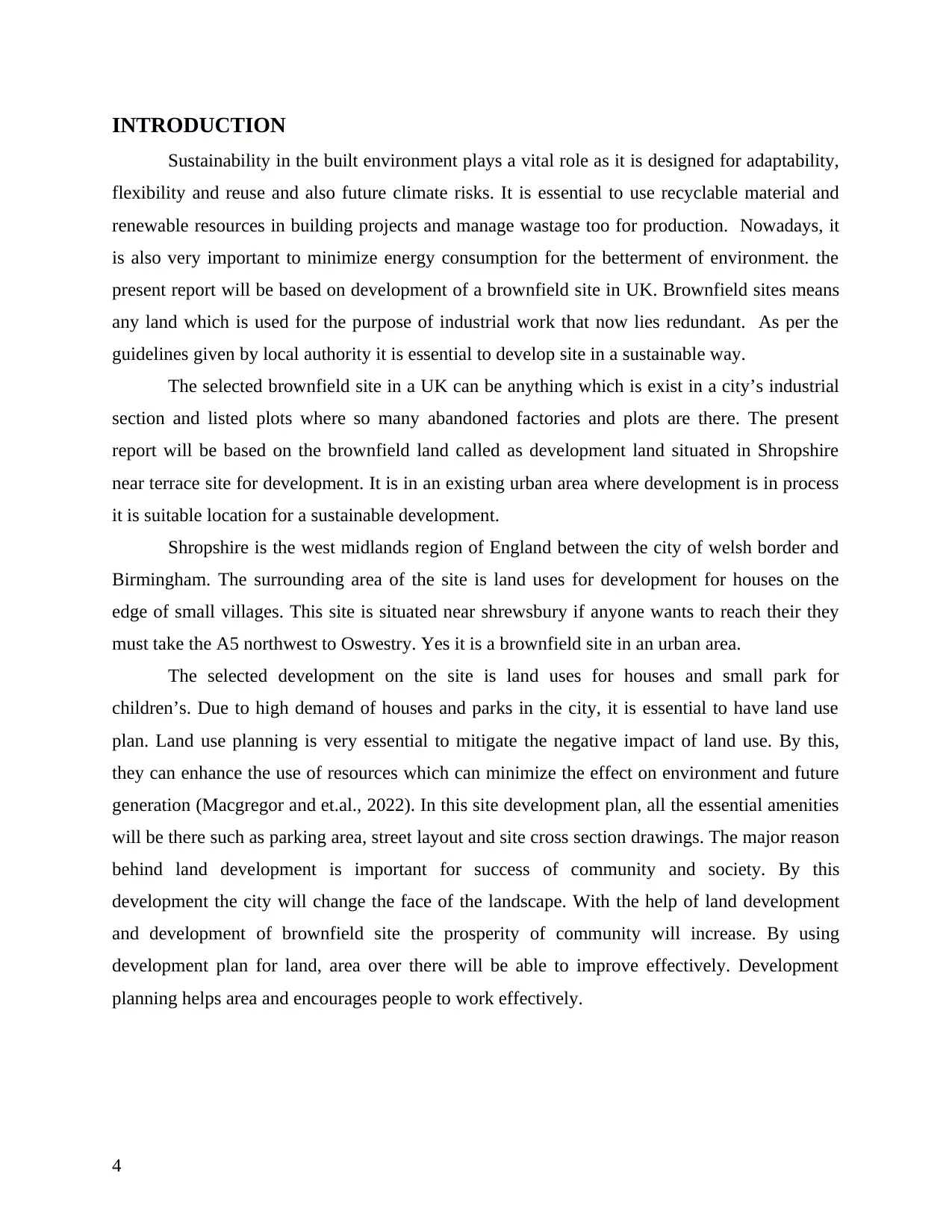
INTRODUCTION
Sustainability in the built environment plays a vital role as it is designed for adaptability,
flexibility and reuse and also future climate risks. It is essential to use recyclable material and
renewable resources in building projects and manage wastage too for production. Nowadays, it
is also very important to minimize energy consumption for the betterment of environment. the
present report will be based on development of a brownfield site in UK. Brownfield sites means
any land which is used for the purpose of industrial work that now lies redundant. As per the
guidelines given by local authority it is essential to develop site in a sustainable way.
The selected brownfield site in a UK can be anything which is exist in a city’s industrial
section and listed plots where so many abandoned factories and plots are there. The present
report will be based on the brownfield land called as development land situated in Shropshire
near terrace site for development. It is in an existing urban area where development is in process
it is suitable location for a sustainable development.
Shropshire is the west midlands region of England between the city of welsh border and
Birmingham. The surrounding area of the site is land uses for development for houses on the
edge of small villages. This site is situated near shrewsbury if anyone wants to reach their they
must take the A5 northwest to Oswestry. Yes it is a brownfield site in an urban area.
The selected development on the site is land uses for houses and small park for
children’s. Due to high demand of houses and parks in the city, it is essential to have land use
plan. Land use planning is very essential to mitigate the negative impact of land use. By this,
they can enhance the use of resources which can minimize the effect on environment and future
generation (Macgregor and et.al., 2022). In this site development plan, all the essential amenities
will be there such as parking area, street layout and site cross section drawings. The major reason
behind land development is important for success of community and society. By this
development the city will change the face of the landscape. With the help of land development
and development of brownfield site the prosperity of community will increase. By using
development plan for land, area over there will be able to improve effectively. Development
planning helps area and encourages people to work effectively.
4
Sustainability in the built environment plays a vital role as it is designed for adaptability,
flexibility and reuse and also future climate risks. It is essential to use recyclable material and
renewable resources in building projects and manage wastage too for production. Nowadays, it
is also very important to minimize energy consumption for the betterment of environment. the
present report will be based on development of a brownfield site in UK. Brownfield sites means
any land which is used for the purpose of industrial work that now lies redundant. As per the
guidelines given by local authority it is essential to develop site in a sustainable way.
The selected brownfield site in a UK can be anything which is exist in a city’s industrial
section and listed plots where so many abandoned factories and plots are there. The present
report will be based on the brownfield land called as development land situated in Shropshire
near terrace site for development. It is in an existing urban area where development is in process
it is suitable location for a sustainable development.
Shropshire is the west midlands region of England between the city of welsh border and
Birmingham. The surrounding area of the site is land uses for development for houses on the
edge of small villages. This site is situated near shrewsbury if anyone wants to reach their they
must take the A5 northwest to Oswestry. Yes it is a brownfield site in an urban area.
The selected development on the site is land uses for houses and small park for
children’s. Due to high demand of houses and parks in the city, it is essential to have land use
plan. Land use planning is very essential to mitigate the negative impact of land use. By this,
they can enhance the use of resources which can minimize the effect on environment and future
generation (Macgregor and et.al., 2022). In this site development plan, all the essential amenities
will be there such as parking area, street layout and site cross section drawings. The major reason
behind land development is important for success of community and society. By this
development the city will change the face of the landscape. With the help of land development
and development of brownfield site the prosperity of community will increase. By using
development plan for land, area over there will be able to improve effectively. Development
planning helps area and encourages people to work effectively.
4
Secure Best Marks with AI Grader
Need help grading? Try our AI Grader for instant feedback on your assignments.
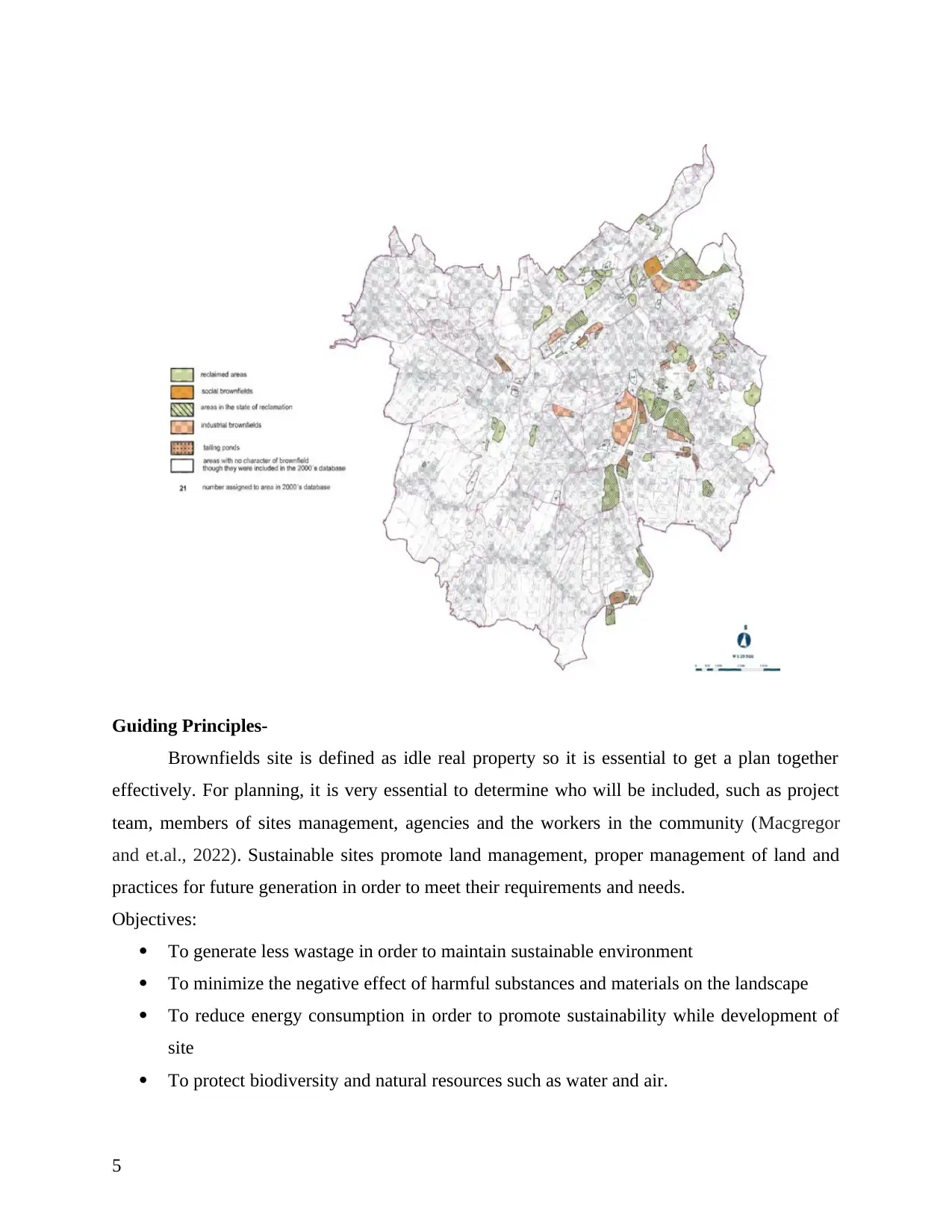
Guiding Principles-
Brownfields site is defined as idle real property so it is essential to get a plan together
effectively. For planning, it is very essential to determine who will be included, such as project
team, members of sites management, agencies and the workers in the community (Macgregor
and et.al., 2022). Sustainable sites promote land management, proper management of land and
practices for future generation in order to meet their requirements and needs.
Objectives:
To generate less wastage in order to maintain sustainable environment
To minimize the negative effect of harmful substances and materials on the landscape
To reduce energy consumption in order to promote sustainability while development of
site
To protect biodiversity and natural resources such as water and air.
5
Brownfields site is defined as idle real property so it is essential to get a plan together
effectively. For planning, it is very essential to determine who will be included, such as project
team, members of sites management, agencies and the workers in the community (Macgregor
and et.al., 2022). Sustainable sites promote land management, proper management of land and
practices for future generation in order to meet their requirements and needs.
Objectives:
To generate less wastage in order to maintain sustainable environment
To minimize the negative effect of harmful substances and materials on the landscape
To reduce energy consumption in order to promote sustainability while development of
site
To protect biodiversity and natural resources such as water and air.
5
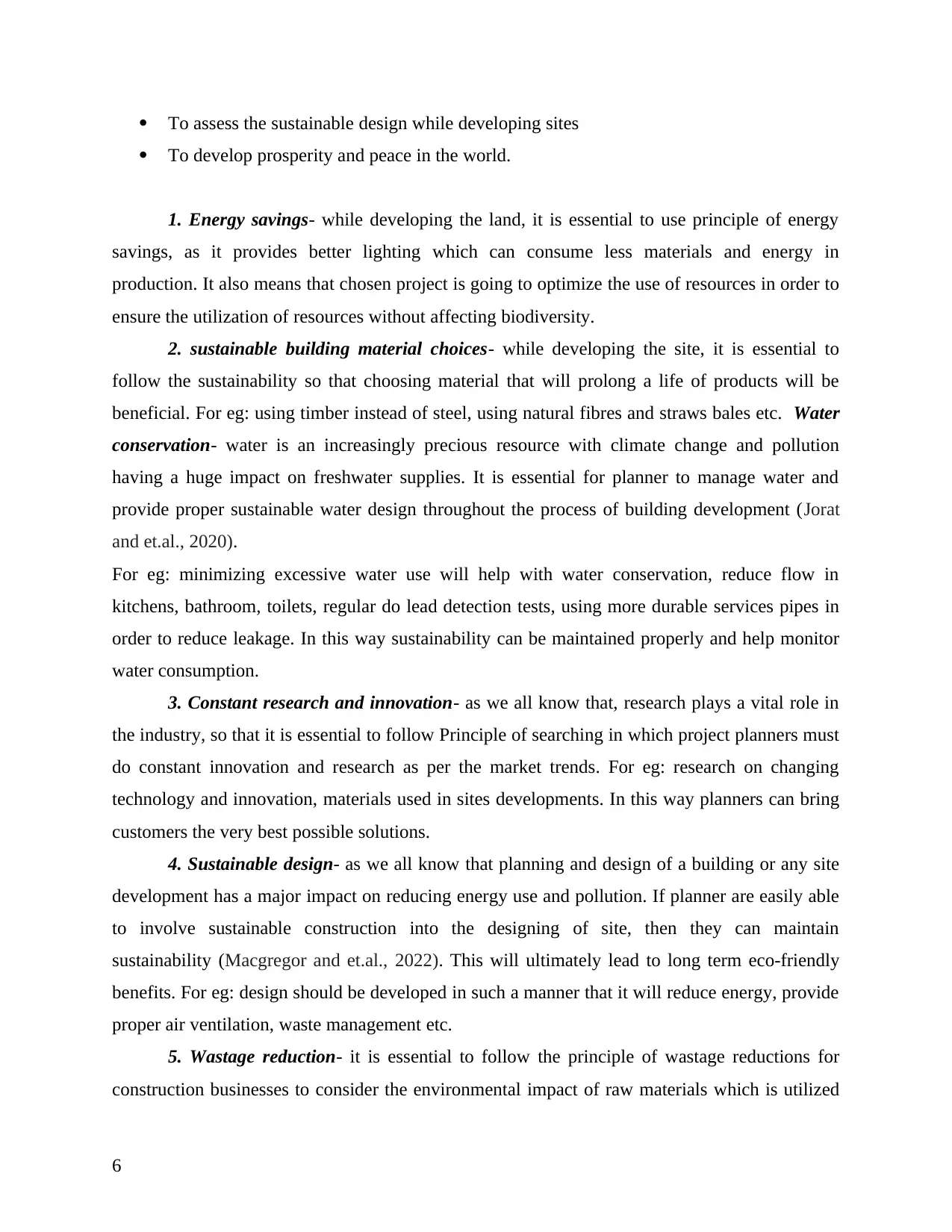
To assess the sustainable design while developing sites
To develop prosperity and peace in the world.
1. Energy savings- while developing the land, it is essential to use principle of energy
savings, as it provides better lighting which can consume less materials and energy in
production. It also means that chosen project is going to optimize the use of resources in order to
ensure the utilization of resources without affecting biodiversity.
2. sustainable building material choices- while developing the site, it is essential to
follow the sustainability so that choosing material that will prolong a life of products will be
beneficial. For eg: using timber instead of steel, using natural fibres and straws bales etc. Water
conservation- water is an increasingly precious resource with climate change and pollution
having a huge impact on freshwater supplies. It is essential for planner to manage water and
provide proper sustainable water design throughout the process of building development (Jorat
and et.al., 2020).
For eg: minimizing excessive water use will help with water conservation, reduce flow in
kitchens, bathroom, toilets, regular do lead detection tests, using more durable services pipes in
order to reduce leakage. In this way sustainability can be maintained properly and help monitor
water consumption.
3. Constant research and innovation- as we all know that, research plays a vital role in
the industry, so that it is essential to follow Principle of searching in which project planners must
do constant innovation and research as per the market trends. For eg: research on changing
technology and innovation, materials used in sites developments. In this way planners can bring
customers the very best possible solutions.
4. Sustainable design- as we all know that planning and design of a building or any site
development has a major impact on reducing energy use and pollution. If planner are easily able
to involve sustainable construction into the designing of site, then they can maintain
sustainability (Macgregor and et.al., 2022). This will ultimately lead to long term eco-friendly
benefits. For eg: design should be developed in such a manner that it will reduce energy, provide
proper air ventilation, waste management etc.
5. Wastage reduction- it is essential to follow the principle of wastage reductions for
construction businesses to consider the environmental impact of raw materials which is utilized
6
To develop prosperity and peace in the world.
1. Energy savings- while developing the land, it is essential to use principle of energy
savings, as it provides better lighting which can consume less materials and energy in
production. It also means that chosen project is going to optimize the use of resources in order to
ensure the utilization of resources without affecting biodiversity.
2. sustainable building material choices- while developing the site, it is essential to
follow the sustainability so that choosing material that will prolong a life of products will be
beneficial. For eg: using timber instead of steel, using natural fibres and straws bales etc. Water
conservation- water is an increasingly precious resource with climate change and pollution
having a huge impact on freshwater supplies. It is essential for planner to manage water and
provide proper sustainable water design throughout the process of building development (Jorat
and et.al., 2020).
For eg: minimizing excessive water use will help with water conservation, reduce flow in
kitchens, bathroom, toilets, regular do lead detection tests, using more durable services pipes in
order to reduce leakage. In this way sustainability can be maintained properly and help monitor
water consumption.
3. Constant research and innovation- as we all know that, research plays a vital role in
the industry, so that it is essential to follow Principle of searching in which project planners must
do constant innovation and research as per the market trends. For eg: research on changing
technology and innovation, materials used in sites developments. In this way planners can bring
customers the very best possible solutions.
4. Sustainable design- as we all know that planning and design of a building or any site
development has a major impact on reducing energy use and pollution. If planner are easily able
to involve sustainable construction into the designing of site, then they can maintain
sustainability (Macgregor and et.al., 2022). This will ultimately lead to long term eco-friendly
benefits. For eg: design should be developed in such a manner that it will reduce energy, provide
proper air ventilation, waste management etc.
5. Wastage reduction- it is essential to follow the principle of wastage reductions for
construction businesses to consider the environmental impact of raw materials which is utilized
6
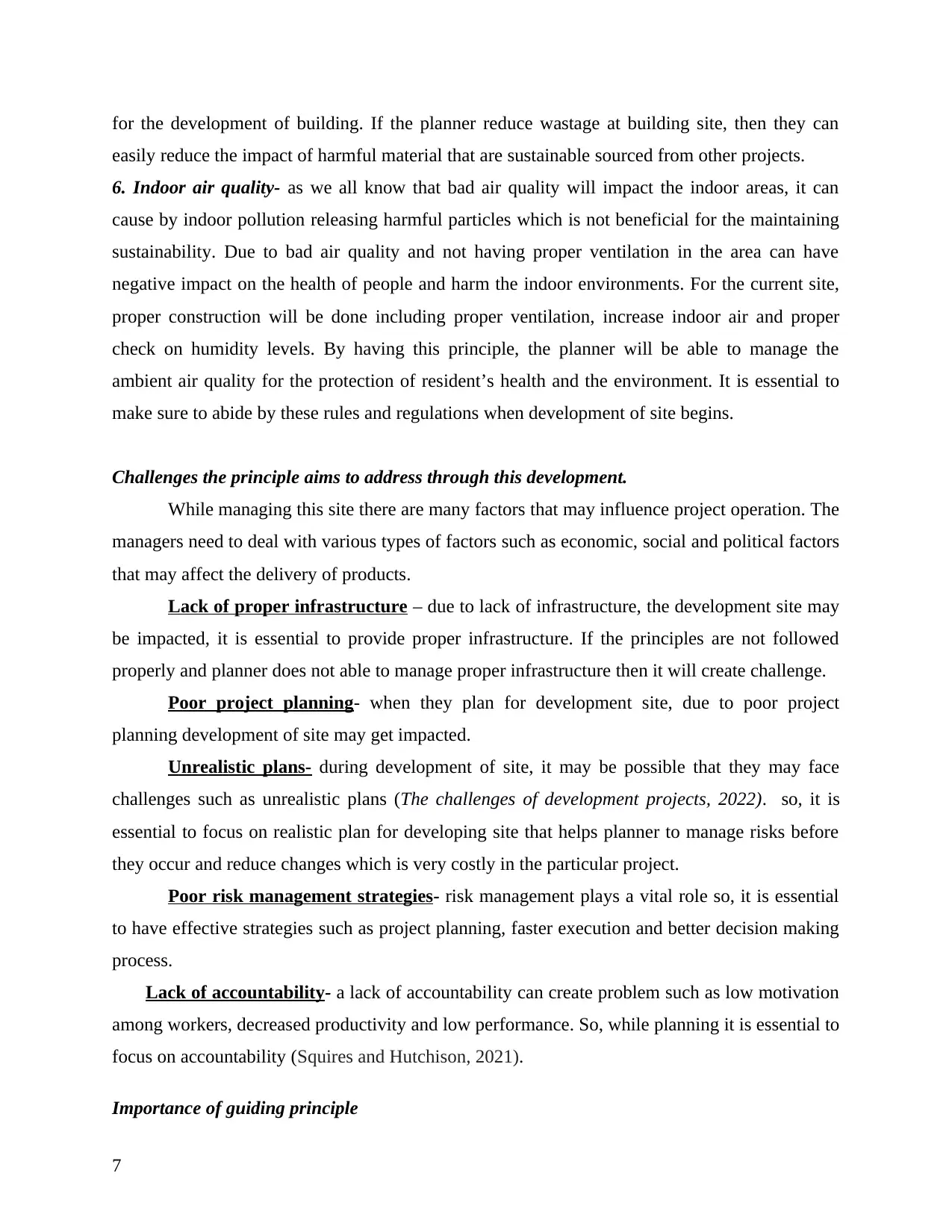
for the development of building. If the planner reduce wastage at building site, then they can
easily reduce the impact of harmful material that are sustainable sourced from other projects.
6. Indoor air quality- as we all know that bad air quality will impact the indoor areas, it can
cause by indoor pollution releasing harmful particles which is not beneficial for the maintaining
sustainability. Due to bad air quality and not having proper ventilation in the area can have
negative impact on the health of people and harm the indoor environments. For the current site,
proper construction will be done including proper ventilation, increase indoor air and proper
check on humidity levels. By having this principle, the planner will be able to manage the
ambient air quality for the protection of resident’s health and the environment. It is essential to
make sure to abide by these rules and regulations when development of site begins.
Challenges the principle aims to address through this development.
While managing this site there are many factors that may influence project operation. The
managers need to deal with various types of factors such as economic, social and political factors
that may affect the delivery of products.
Lack of proper infrastructure – due to lack of infrastructure, the development site may
be impacted, it is essential to provide proper infrastructure. If the principles are not followed
properly and planner does not able to manage proper infrastructure then it will create challenge.
Poor project planning- when they plan for development site, due to poor project
planning development of site may get impacted.
Unrealistic plans- during development of site, it may be possible that they may face
challenges such as unrealistic plans (The challenges of development projects, 2022). so, it is
essential to focus on realistic plan for developing site that helps planner to manage risks before
they occur and reduce changes which is very costly in the particular project.
Poor risk management strategies- risk management plays a vital role so, it is essential
to have effective strategies such as project planning, faster execution and better decision making
process.
Lack of accountability- a lack of accountability can create problem such as low motivation
among workers, decreased productivity and low performance. So, while planning it is essential to
focus on accountability (Squires and Hutchison, 2021).
Importance of guiding principle
7
easily reduce the impact of harmful material that are sustainable sourced from other projects.
6. Indoor air quality- as we all know that bad air quality will impact the indoor areas, it can
cause by indoor pollution releasing harmful particles which is not beneficial for the maintaining
sustainability. Due to bad air quality and not having proper ventilation in the area can have
negative impact on the health of people and harm the indoor environments. For the current site,
proper construction will be done including proper ventilation, increase indoor air and proper
check on humidity levels. By having this principle, the planner will be able to manage the
ambient air quality for the protection of resident’s health and the environment. It is essential to
make sure to abide by these rules and regulations when development of site begins.
Challenges the principle aims to address through this development.
While managing this site there are many factors that may influence project operation. The
managers need to deal with various types of factors such as economic, social and political factors
that may affect the delivery of products.
Lack of proper infrastructure – due to lack of infrastructure, the development site may
be impacted, it is essential to provide proper infrastructure. If the principles are not followed
properly and planner does not able to manage proper infrastructure then it will create challenge.
Poor project planning- when they plan for development site, due to poor project
planning development of site may get impacted.
Unrealistic plans- during development of site, it may be possible that they may face
challenges such as unrealistic plans (The challenges of development projects, 2022). so, it is
essential to focus on realistic plan for developing site that helps planner to manage risks before
they occur and reduce changes which is very costly in the particular project.
Poor risk management strategies- risk management plays a vital role so, it is essential
to have effective strategies such as project planning, faster execution and better decision making
process.
Lack of accountability- a lack of accountability can create problem such as low motivation
among workers, decreased productivity and low performance. So, while planning it is essential to
focus on accountability (Squires and Hutchison, 2021).
Importance of guiding principle
7
Paraphrase This Document
Need a fresh take? Get an instant paraphrase of this document with our AI Paraphraser
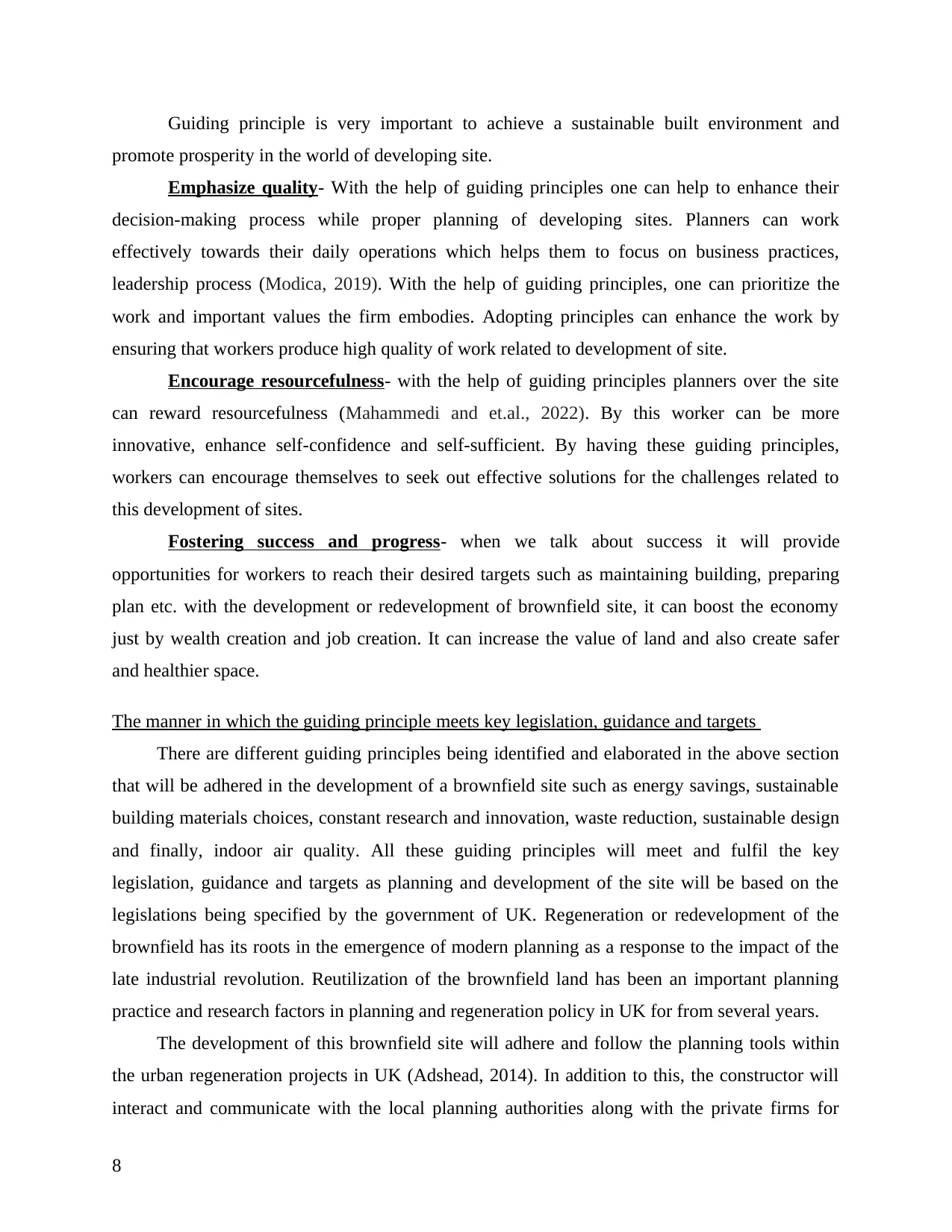
Guiding principle is very important to achieve a sustainable built environment and
promote prosperity in the world of developing site.
Emphasize quality- With the help of guiding principles one can help to enhance their
decision-making process while proper planning of developing sites. Planners can work
effectively towards their daily operations which helps them to focus on business practices,
leadership process (Modica, 2019). With the help of guiding principles, one can prioritize the
work and important values the firm embodies. Adopting principles can enhance the work by
ensuring that workers produce high quality of work related to development of site.
Encourage resourcefulness- with the help of guiding principles planners over the site
can reward resourcefulness (Mahammedi and et.al., 2022). By this worker can be more
innovative, enhance self-confidence and self-sufficient. By having these guiding principles,
workers can encourage themselves to seek out effective solutions for the challenges related to
this development of sites.
Fostering success and progress- when we talk about success it will provide
opportunities for workers to reach their desired targets such as maintaining building, preparing
plan etc. with the development or redevelopment of brownfield site, it can boost the economy
just by wealth creation and job creation. It can increase the value of land and also create safer
and healthier space.
The manner in which the guiding principle meets key legislation, guidance and targets
There are different guiding principles being identified and elaborated in the above section
that will be adhered in the development of a brownfield site such as energy savings, sustainable
building materials choices, constant research and innovation, waste reduction, sustainable design
and finally, indoor air quality. All these guiding principles will meet and fulfil the key
legislation, guidance and targets as planning and development of the site will be based on the
legislations being specified by the government of UK. Regeneration or redevelopment of the
brownfield has its roots in the emergence of modern planning as a response to the impact of the
late industrial revolution. Reutilization of the brownfield land has been an important planning
practice and research factors in planning and regeneration policy in UK for from several years.
The development of this brownfield site will adhere and follow the planning tools within
the urban regeneration projects in UK (Adshead, 2014). In addition to this, the constructor will
interact and communicate with the local planning authorities along with the private firms for
8
promote prosperity in the world of developing site.
Emphasize quality- With the help of guiding principles one can help to enhance their
decision-making process while proper planning of developing sites. Planners can work
effectively towards their daily operations which helps them to focus on business practices,
leadership process (Modica, 2019). With the help of guiding principles, one can prioritize the
work and important values the firm embodies. Adopting principles can enhance the work by
ensuring that workers produce high quality of work related to development of site.
Encourage resourcefulness- with the help of guiding principles planners over the site
can reward resourcefulness (Mahammedi and et.al., 2022). By this worker can be more
innovative, enhance self-confidence and self-sufficient. By having these guiding principles,
workers can encourage themselves to seek out effective solutions for the challenges related to
this development of sites.
Fostering success and progress- when we talk about success it will provide
opportunities for workers to reach their desired targets such as maintaining building, preparing
plan etc. with the development or redevelopment of brownfield site, it can boost the economy
just by wealth creation and job creation. It can increase the value of land and also create safer
and healthier space.
The manner in which the guiding principle meets key legislation, guidance and targets
There are different guiding principles being identified and elaborated in the above section
that will be adhered in the development of a brownfield site such as energy savings, sustainable
building materials choices, constant research and innovation, waste reduction, sustainable design
and finally, indoor air quality. All these guiding principles will meet and fulfil the key
legislation, guidance and targets as planning and development of the site will be based on the
legislations being specified by the government of UK. Regeneration or redevelopment of the
brownfield has its roots in the emergence of modern planning as a response to the impact of the
late industrial revolution. Reutilization of the brownfield land has been an important planning
practice and research factors in planning and regeneration policy in UK for from several years.
The development of this brownfield site will adhere and follow the planning tools within
the urban regeneration projects in UK (Adshead, 2014). In addition to this, the constructor will
interact and communicate with the local planning authorities along with the private firms for
8
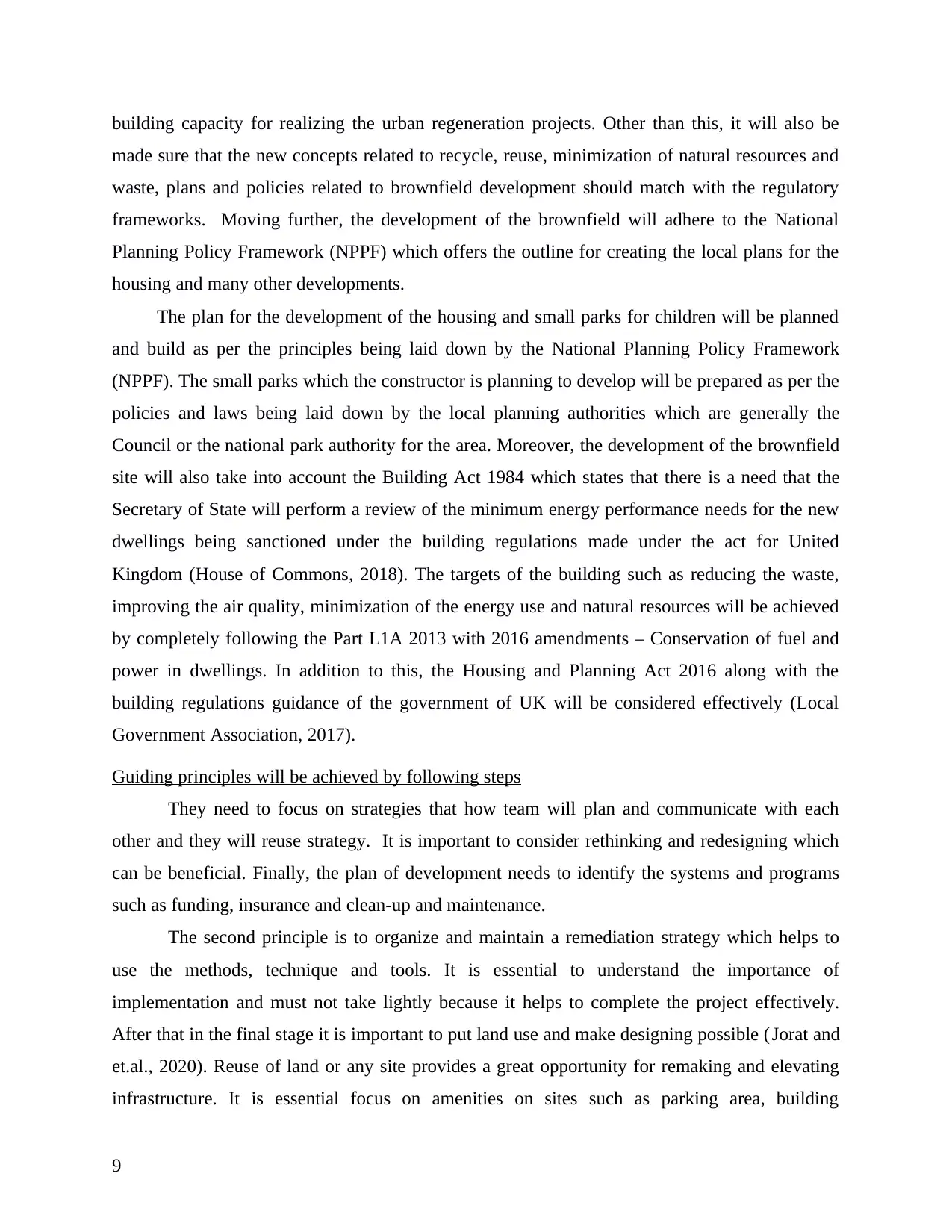
building capacity for realizing the urban regeneration projects. Other than this, it will also be
made sure that the new concepts related to recycle, reuse, minimization of natural resources and
waste, plans and policies related to brownfield development should match with the regulatory
frameworks. Moving further, the development of the brownfield will adhere to the National
Planning Policy Framework (NPPF) which offers the outline for creating the local plans for the
housing and many other developments.
The plan for the development of the housing and small parks for children will be planned
and build as per the principles being laid down by the National Planning Policy Framework
(NPPF). The small parks which the constructor is planning to develop will be prepared as per the
policies and laws being laid down by the local planning authorities which are generally the
Council or the national park authority for the area. Moreover, the development of the brownfield
site will also take into account the Building Act 1984 which states that there is a need that the
Secretary of State will perform a review of the minimum energy performance needs for the new
dwellings being sanctioned under the building regulations made under the act for United
Kingdom (House of Commons, 2018). The targets of the building such as reducing the waste,
improving the air quality, minimization of the energy use and natural resources will be achieved
by completely following the Part L1A 2013 with 2016 amendments – Conservation of fuel and
power in dwellings. In addition to this, the Housing and Planning Act 2016 along with the
building regulations guidance of the government of UK will be considered effectively (Local
Government Association, 2017).
Guiding principles will be achieved by following steps
They need to focus on strategies that how team will plan and communicate with each
other and they will reuse strategy. It is important to consider rethinking and redesigning which
can be beneficial. Finally, the plan of development needs to identify the systems and programs
such as funding, insurance and clean-up and maintenance.
The second principle is to organize and maintain a remediation strategy which helps to
use the methods, technique and tools. It is essential to understand the importance of
implementation and must not take lightly because it helps to complete the project effectively.
After that in the final stage it is important to put land use and make designing possible ( Jorat and
et.al., 2020). Reuse of land or any site provides a great opportunity for remaking and elevating
infrastructure. It is essential focus on amenities on sites such as parking area, building
9
made sure that the new concepts related to recycle, reuse, minimization of natural resources and
waste, plans and policies related to brownfield development should match with the regulatory
frameworks. Moving further, the development of the brownfield will adhere to the National
Planning Policy Framework (NPPF) which offers the outline for creating the local plans for the
housing and many other developments.
The plan for the development of the housing and small parks for children will be planned
and build as per the principles being laid down by the National Planning Policy Framework
(NPPF). The small parks which the constructor is planning to develop will be prepared as per the
policies and laws being laid down by the local planning authorities which are generally the
Council or the national park authority for the area. Moreover, the development of the brownfield
site will also take into account the Building Act 1984 which states that there is a need that the
Secretary of State will perform a review of the minimum energy performance needs for the new
dwellings being sanctioned under the building regulations made under the act for United
Kingdom (House of Commons, 2018). The targets of the building such as reducing the waste,
improving the air quality, minimization of the energy use and natural resources will be achieved
by completely following the Part L1A 2013 with 2016 amendments – Conservation of fuel and
power in dwellings. In addition to this, the Housing and Planning Act 2016 along with the
building regulations guidance of the government of UK will be considered effectively (Local
Government Association, 2017).
Guiding principles will be achieved by following steps
They need to focus on strategies that how team will plan and communicate with each
other and they will reuse strategy. It is important to consider rethinking and redesigning which
can be beneficial. Finally, the plan of development needs to identify the systems and programs
such as funding, insurance and clean-up and maintenance.
The second principle is to organize and maintain a remediation strategy which helps to
use the methods, technique and tools. It is essential to understand the importance of
implementation and must not take lightly because it helps to complete the project effectively.
After that in the final stage it is important to put land use and make designing possible ( Jorat and
et.al., 2020). Reuse of land or any site provides a great opportunity for remaking and elevating
infrastructure. It is essential focus on amenities on sites such as parking area, building
9
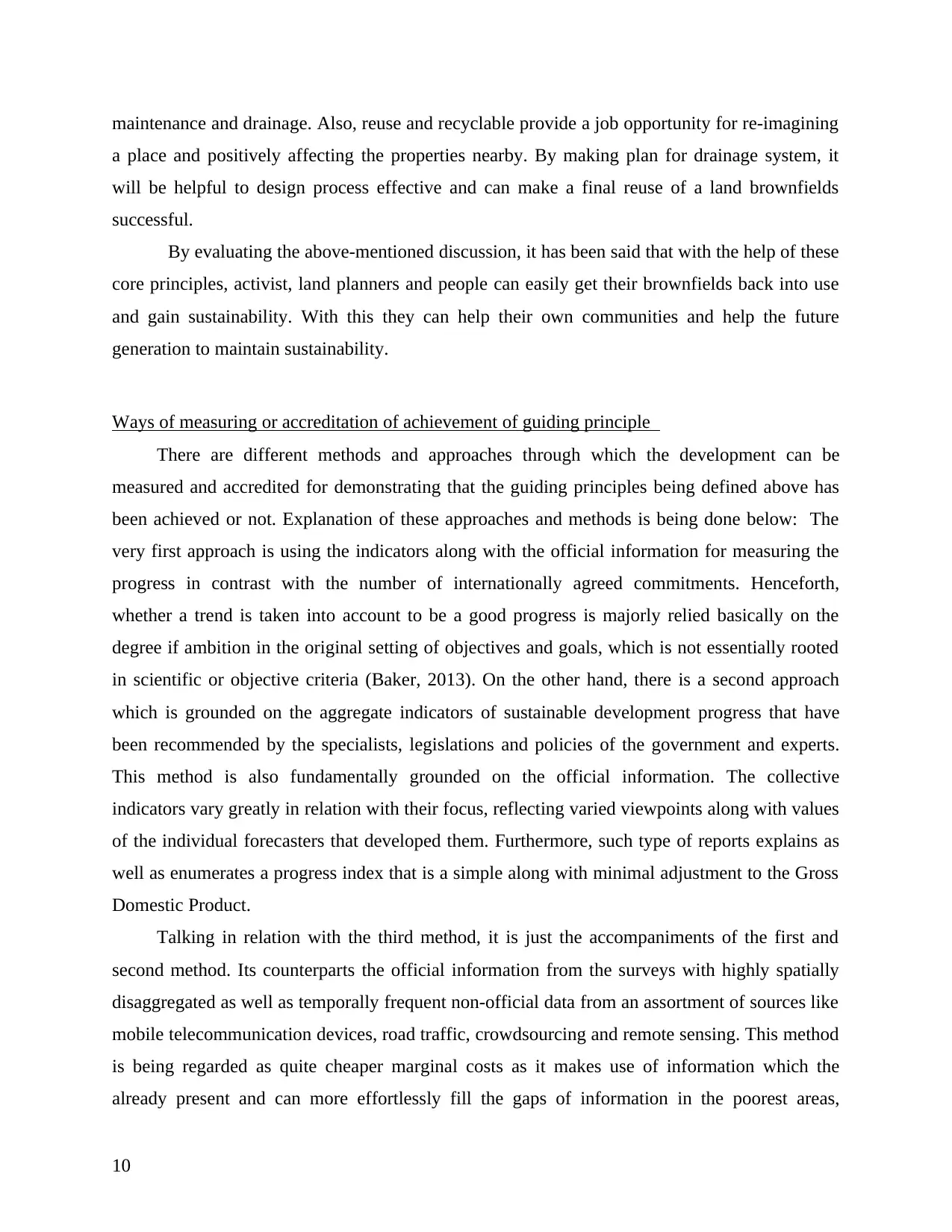
maintenance and drainage. Also, reuse and recyclable provide a job opportunity for re-imagining
a place and positively affecting the properties nearby. By making plan for drainage system, it
will be helpful to design process effective and can make a final reuse of a land brownfields
successful.
By evaluating the above-mentioned discussion, it has been said that with the help of these
core principles, activist, land planners and people can easily get their brownfields back into use
and gain sustainability. With this they can help their own communities and help the future
generation to maintain sustainability.
Ways of measuring or accreditation of achievement of guiding principle
There are different methods and approaches through which the development can be
measured and accredited for demonstrating that the guiding principles being defined above has
been achieved or not. Explanation of these approaches and methods is being done below: The
very first approach is using the indicators along with the official information for measuring the
progress in contrast with the number of internationally agreed commitments. Henceforth,
whether a trend is taken into account to be a good progress is majorly relied basically on the
degree if ambition in the original setting of objectives and goals, which is not essentially rooted
in scientific or objective criteria (Baker, 2013). On the other hand, there is a second approach
which is grounded on the aggregate indicators of sustainable development progress that have
been recommended by the specialists, legislations and policies of the government and experts.
This method is also fundamentally grounded on the official information. The collective
indicators vary greatly in relation with their focus, reflecting varied viewpoints along with values
of the individual forecasters that developed them. Furthermore, such type of reports explains as
well as enumerates a progress index that is a simple along with minimal adjustment to the Gross
Domestic Product.
Talking in relation with the third method, it is just the accompaniments of the first and
second method. Its counterparts the official information from the surveys with highly spatially
disaggregated as well as temporally frequent non-official data from an assortment of sources like
mobile telecommunication devices, road traffic, crowdsourcing and remote sensing. This method
is being regarded as quite cheaper marginal costs as it makes use of information which the
already present and can more effortlessly fill the gaps of information in the poorest areas,
10
a place and positively affecting the properties nearby. By making plan for drainage system, it
will be helpful to design process effective and can make a final reuse of a land brownfields
successful.
By evaluating the above-mentioned discussion, it has been said that with the help of these
core principles, activist, land planners and people can easily get their brownfields back into use
and gain sustainability. With this they can help their own communities and help the future
generation to maintain sustainability.
Ways of measuring or accreditation of achievement of guiding principle
There are different methods and approaches through which the development can be
measured and accredited for demonstrating that the guiding principles being defined above has
been achieved or not. Explanation of these approaches and methods is being done below: The
very first approach is using the indicators along with the official information for measuring the
progress in contrast with the number of internationally agreed commitments. Henceforth,
whether a trend is taken into account to be a good progress is majorly relied basically on the
degree if ambition in the original setting of objectives and goals, which is not essentially rooted
in scientific or objective criteria (Baker, 2013). On the other hand, there is a second approach
which is grounded on the aggregate indicators of sustainable development progress that have
been recommended by the specialists, legislations and policies of the government and experts.
This method is also fundamentally grounded on the official information. The collective
indicators vary greatly in relation with their focus, reflecting varied viewpoints along with values
of the individual forecasters that developed them. Furthermore, such type of reports explains as
well as enumerates a progress index that is a simple along with minimal adjustment to the Gross
Domestic Product.
Talking in relation with the third method, it is just the accompaniments of the first and
second method. Its counterparts the official information from the surveys with highly spatially
disaggregated as well as temporally frequent non-official data from an assortment of sources like
mobile telecommunication devices, road traffic, crowdsourcing and remote sensing. This method
is being regarded as quite cheaper marginal costs as it makes use of information which the
already present and can more effortlessly fill the gaps of information in the poorest areas,
10
Secure Best Marks with AI Grader
Need help grading? Try our AI Grader for instant feedback on your assignments.
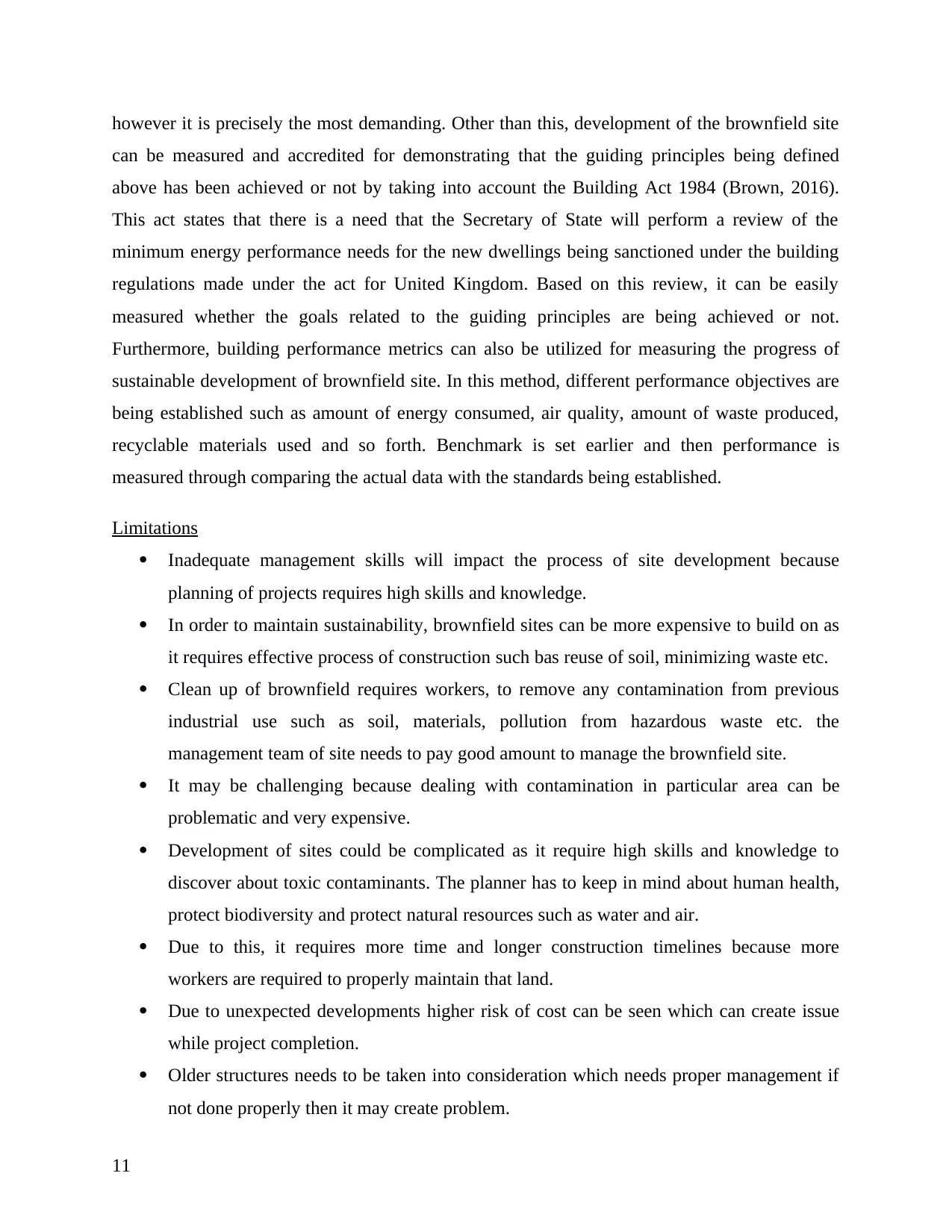
however it is precisely the most demanding. Other than this, development of the brownfield site
can be measured and accredited for demonstrating that the guiding principles being defined
above has been achieved or not by taking into account the Building Act 1984 (Brown, 2016).
This act states that there is a need that the Secretary of State will perform a review of the
minimum energy performance needs for the new dwellings being sanctioned under the building
regulations made under the act for United Kingdom. Based on this review, it can be easily
measured whether the goals related to the guiding principles are being achieved or not.
Furthermore, building performance metrics can also be utilized for measuring the progress of
sustainable development of brownfield site. In this method, different performance objectives are
being established such as amount of energy consumed, air quality, amount of waste produced,
recyclable materials used and so forth. Benchmark is set earlier and then performance is
measured through comparing the actual data with the standards being established.
Limitations
Inadequate management skills will impact the process of site development because
planning of projects requires high skills and knowledge.
In order to maintain sustainability, brownfield sites can be more expensive to build on as
it requires effective process of construction such bas reuse of soil, minimizing waste etc.
Clean up of brownfield requires workers, to remove any contamination from previous
industrial use such as soil, materials, pollution from hazardous waste etc. the
management team of site needs to pay good amount to manage the brownfield site.
It may be challenging because dealing with contamination in particular area can be
problematic and very expensive.
Development of sites could be complicated as it require high skills and knowledge to
discover about toxic contaminants. The planner has to keep in mind about human health,
protect biodiversity and protect natural resources such as water and air.
Due to this, it requires more time and longer construction timelines because more
workers are required to properly maintain that land.
Due to unexpected developments higher risk of cost can be seen which can create issue
while project completion.
Older structures needs to be taken into consideration which needs proper management if
not done properly then it may create problem.
11
can be measured and accredited for demonstrating that the guiding principles being defined
above has been achieved or not by taking into account the Building Act 1984 (Brown, 2016).
This act states that there is a need that the Secretary of State will perform a review of the
minimum energy performance needs for the new dwellings being sanctioned under the building
regulations made under the act for United Kingdom. Based on this review, it can be easily
measured whether the goals related to the guiding principles are being achieved or not.
Furthermore, building performance metrics can also be utilized for measuring the progress of
sustainable development of brownfield site. In this method, different performance objectives are
being established such as amount of energy consumed, air quality, amount of waste produced,
recyclable materials used and so forth. Benchmark is set earlier and then performance is
measured through comparing the actual data with the standards being established.
Limitations
Inadequate management skills will impact the process of site development because
planning of projects requires high skills and knowledge.
In order to maintain sustainability, brownfield sites can be more expensive to build on as
it requires effective process of construction such bas reuse of soil, minimizing waste etc.
Clean up of brownfield requires workers, to remove any contamination from previous
industrial use such as soil, materials, pollution from hazardous waste etc. the
management team of site needs to pay good amount to manage the brownfield site.
It may be challenging because dealing with contamination in particular area can be
problematic and very expensive.
Development of sites could be complicated as it require high skills and knowledge to
discover about toxic contaminants. The planner has to keep in mind about human health,
protect biodiversity and protect natural resources such as water and air.
Due to this, it requires more time and longer construction timelines because more
workers are required to properly maintain that land.
Due to unexpected developments higher risk of cost can be seen which can create issue
while project completion.
Older structures needs to be taken into consideration which needs proper management if
not done properly then it may create problem.
11
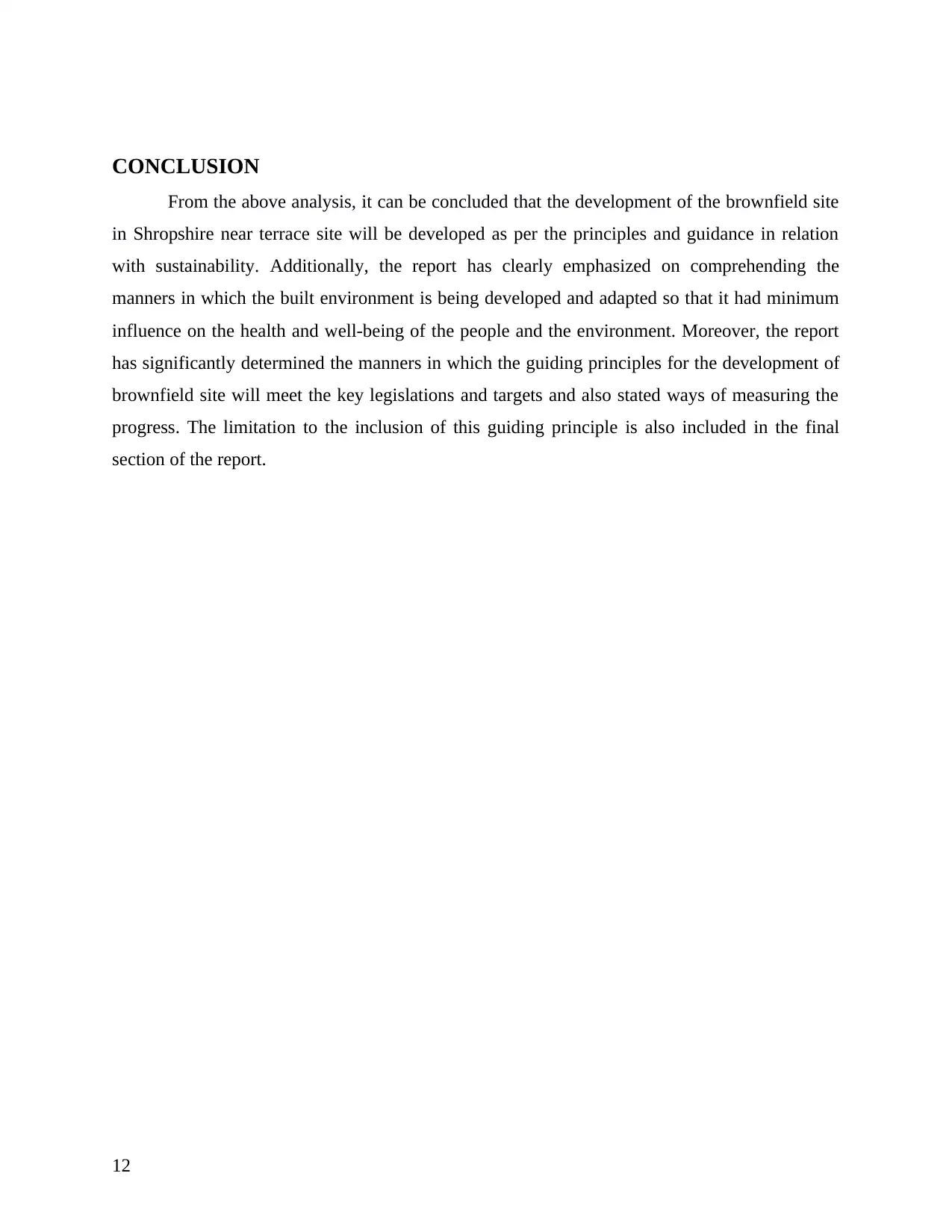
CONCLUSION
From the above analysis, it can be concluded that the development of the brownfield site
in Shropshire near terrace site will be developed as per the principles and guidance in relation
with sustainability. Additionally, the report has clearly emphasized on comprehending the
manners in which the built environment is being developed and adapted so that it had minimum
influence on the health and well-being of the people and the environment. Moreover, the report
has significantly determined the manners in which the guiding principles for the development of
brownfield site will meet the key legislations and targets and also stated ways of measuring the
progress. The limitation to the inclusion of this guiding principle is also included in the final
section of the report.
12
From the above analysis, it can be concluded that the development of the brownfield site
in Shropshire near terrace site will be developed as per the principles and guidance in relation
with sustainability. Additionally, the report has clearly emphasized on comprehending the
manners in which the built environment is being developed and adapted so that it had minimum
influence on the health and well-being of the people and the environment. Moreover, the report
has significantly determined the manners in which the guiding principles for the development of
brownfield site will meet the key legislations and targets and also stated ways of measuring the
progress. The limitation to the inclusion of this guiding principle is also included in the final
section of the report.
12
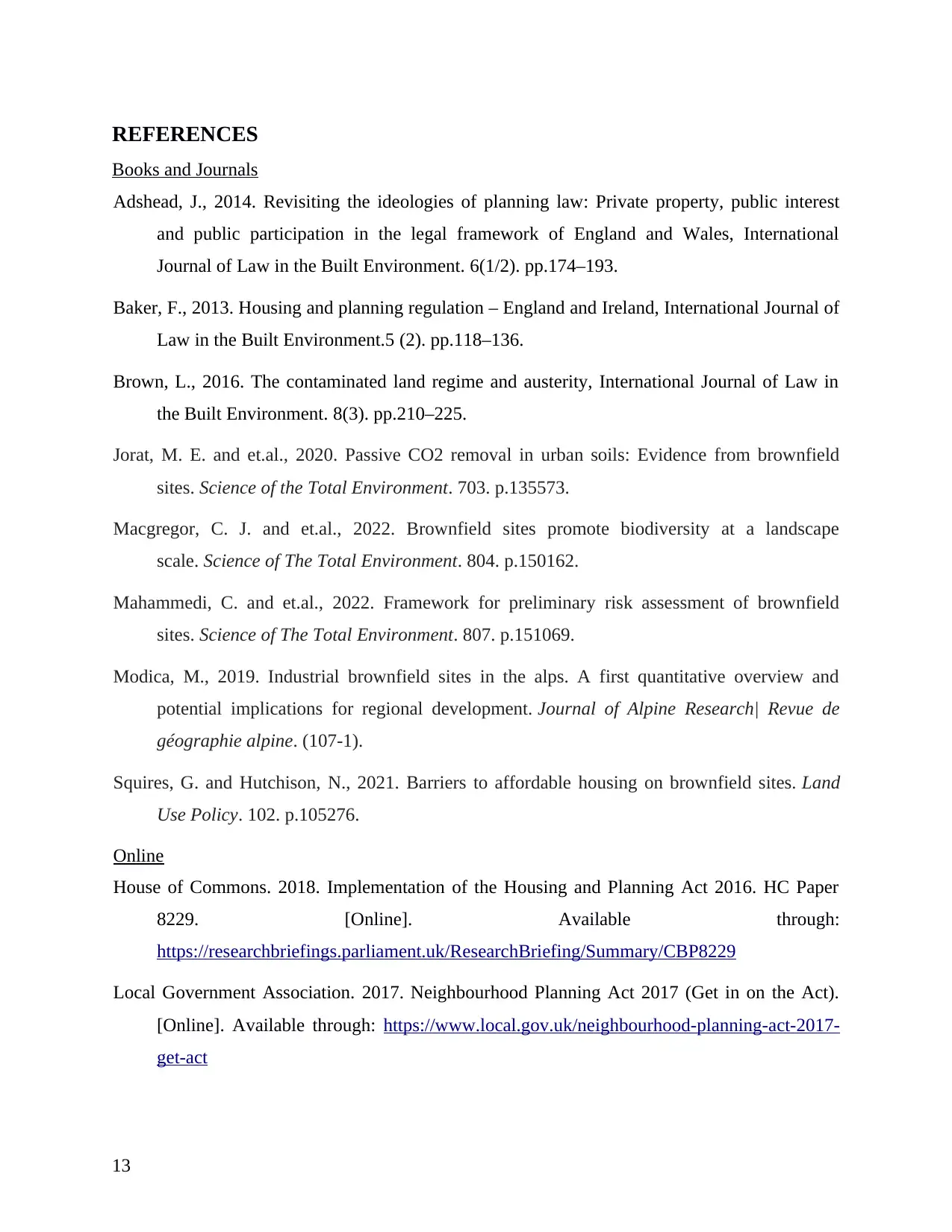
REFERENCES
Books and Journals
Adshead, J., 2014. Revisiting the ideologies of planning law: Private property, public interest
and public participation in the legal framework of England and Wales, International
Journal of Law in the Built Environment. 6(1/2). pp.174–193.
Baker, F., 2013. Housing and planning regulation – England and Ireland, International Journal of
Law in the Built Environment.5 (2). pp.118–136.
Brown, L., 2016. The contaminated land regime and austerity, International Journal of Law in
the Built Environment. 8(3). pp.210–225.
Jorat, M. E. and et.al., 2020. Passive CO2 removal in urban soils: Evidence from brownfield
sites. Science of the Total Environment. 703. p.135573.
Macgregor, C. J. and et.al., 2022. Brownfield sites promote biodiversity at a landscape
scale. Science of The Total Environment. 804. p.150162.
Mahammedi, C. and et.al., 2022. Framework for preliminary risk assessment of brownfield
sites. Science of The Total Environment. 807. p.151069.
Modica, M., 2019. Industrial brownfield sites in the alps. A first quantitative overview and
potential implications for regional development. Journal of Alpine Research| Revue de
géographie alpine. (107-1).
Squires, G. and Hutchison, N., 2021. Barriers to affordable housing on brownfield sites. Land
Use Policy. 102. p.105276.
Online
House of Commons. 2018. Implementation of the Housing and Planning Act 2016. HC Paper
8229. [Online]. Available through:
https://researchbriefings.parliament.uk/ResearchBriefing/Summary/CBP8229
Local Government Association. 2017. Neighbourhood Planning Act 2017 (Get in on the Act).
[Online]. Available through: https://www.local.gov.uk/neighbourhood-planning-act-2017-
get-act
13
Books and Journals
Adshead, J., 2014. Revisiting the ideologies of planning law: Private property, public interest
and public participation in the legal framework of England and Wales, International
Journal of Law in the Built Environment. 6(1/2). pp.174–193.
Baker, F., 2013. Housing and planning regulation – England and Ireland, International Journal of
Law in the Built Environment.5 (2). pp.118–136.
Brown, L., 2016. The contaminated land regime and austerity, International Journal of Law in
the Built Environment. 8(3). pp.210–225.
Jorat, M. E. and et.al., 2020. Passive CO2 removal in urban soils: Evidence from brownfield
sites. Science of the Total Environment. 703. p.135573.
Macgregor, C. J. and et.al., 2022. Brownfield sites promote biodiversity at a landscape
scale. Science of The Total Environment. 804. p.150162.
Mahammedi, C. and et.al., 2022. Framework for preliminary risk assessment of brownfield
sites. Science of The Total Environment. 807. p.151069.
Modica, M., 2019. Industrial brownfield sites in the alps. A first quantitative overview and
potential implications for regional development. Journal of Alpine Research| Revue de
géographie alpine. (107-1).
Squires, G. and Hutchison, N., 2021. Barriers to affordable housing on brownfield sites. Land
Use Policy. 102. p.105276.
Online
House of Commons. 2018. Implementation of the Housing and Planning Act 2016. HC Paper
8229. [Online]. Available through:
https://researchbriefings.parliament.uk/ResearchBriefing/Summary/CBP8229
Local Government Association. 2017. Neighbourhood Planning Act 2017 (Get in on the Act).
[Online]. Available through: https://www.local.gov.uk/neighbourhood-planning-act-2017-
get-act
13
Paraphrase This Document
Need a fresh take? Get an instant paraphrase of this document with our AI Paraphraser
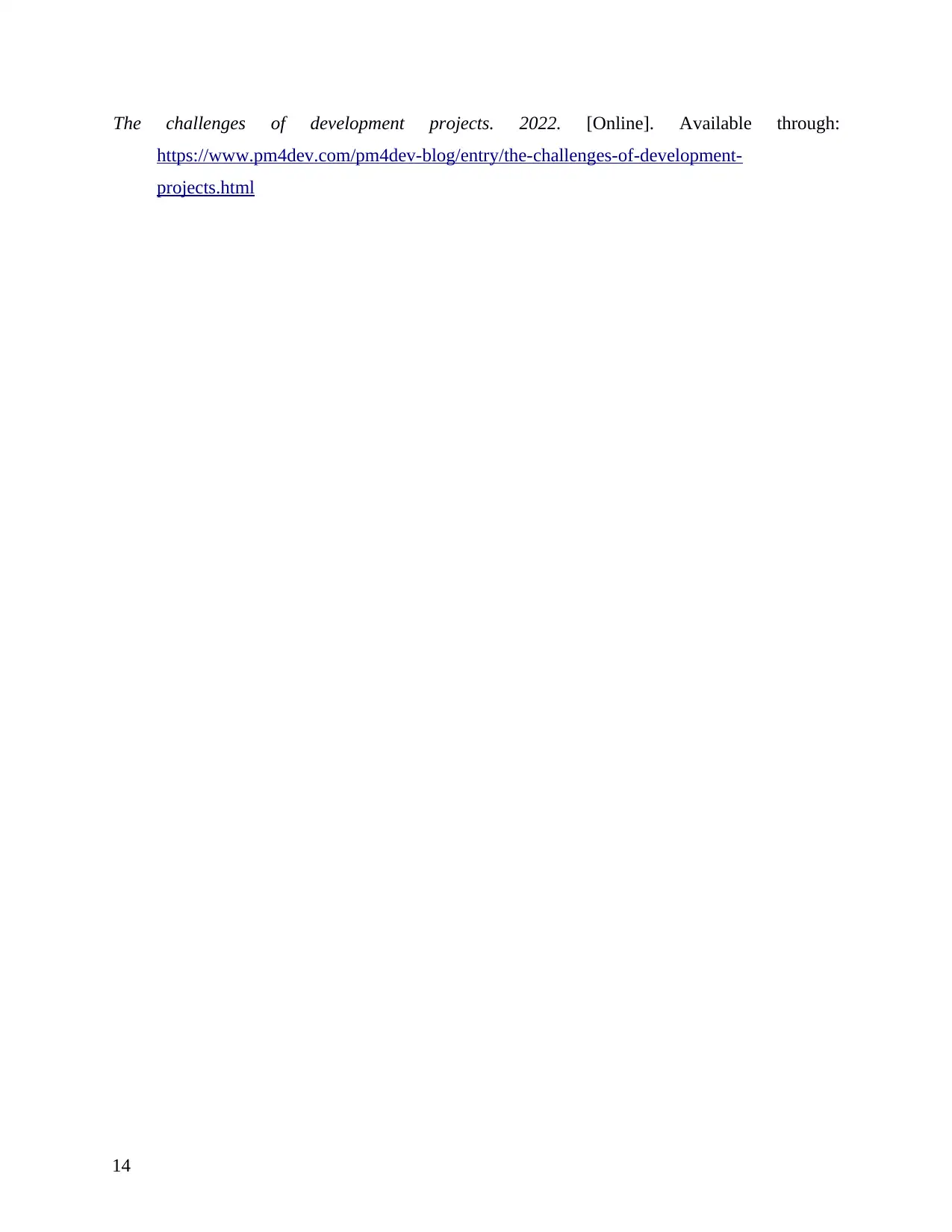
The challenges of development projects. 2022. [Online]. Available through:
https://www.pm4dev.com/pm4dev-blog/entry/the-challenges-of-development-
projects.html
14
https://www.pm4dev.com/pm4dev-blog/entry/the-challenges-of-development-
projects.html
14
1 out of 14
Related Documents
Your All-in-One AI-Powered Toolkit for Academic Success.
+13062052269
info@desklib.com
Available 24*7 on WhatsApp / Email
![[object Object]](/_next/static/media/star-bottom.7253800d.svg)
Unlock your academic potential
© 2024 | Zucol Services PVT LTD | All rights reserved.





